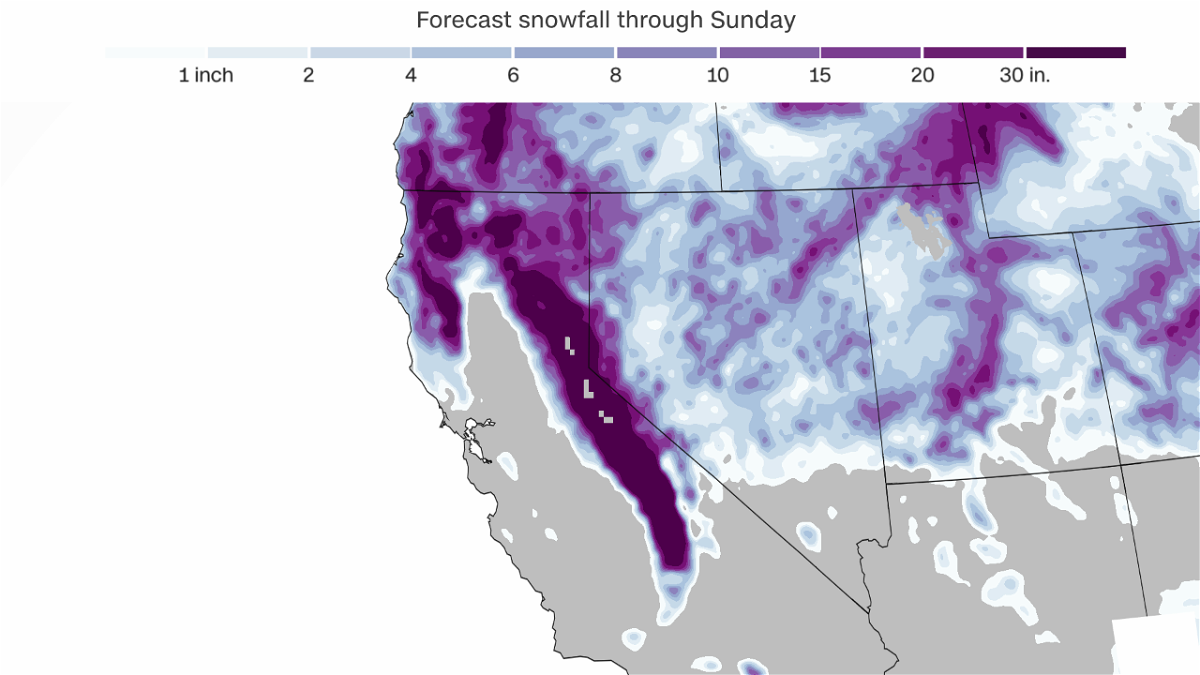Blockbuster California storm to deliver crushing blow of 10 feet of snow and blizzard conditions

Originally Published: 29 FEB 24 11:38 ET By Mary Gilbert and Elliana Hebert, CNN
(CNN) — An extremely-dangerous winter storm has arrived in California and will unload feet of snow, powerful winds and rare blizzard conditions in the mountains through the weekend.
The storm willbury California under its biggest snowfall of the year, posing a significant danger to travelers – but provide a huge boost for the state’s water supply and tourism.
“There are only so many ways that we can say it will be treacherous to be traveling on the roads or even exiting your home during this [storm],” the National Weather Service office in Reno, Nevada, warned Wednesday. “Whiteout conditions are very disorienting, so this is not the time to gamble with you or your family’s lives.”
Snow began to fall in the Pacific Northwest late Wednesday and spread into California’s Northern Coast Range and the Klamath Mountains early Thursday. Snow will arrive for much of the Sierra Nevada by Thursday evening. As snow spreads across California, so will strong winds and blizzard conditions.
Snowfall rates are expected to reach extreme levels of 3 to 5 inches an hour from Friday through Saturday – especially along the Sierra Nevada.
The prolonged extreme snowfall means 6 to 10 feet of snow could bury parts of the Sierra in just a matter of two to three days.
The most extreme conditions will unfold at the highest elevations, with wind gusts in excess of 100 mph expected on the highest peaks of the Sierra in addition to feet of snow. Winds are expected to blow so hard that it may be difficult to measure snow accurately with the potential for huge snow drifts.
Heavy snow and roaring winds are expected to combine to produce rare and long-lasting blizzard conditions for much of the Sierra and parts of the northern ranges. Visibility could plummet to near-zero, meaning it’s impossible to see farther than a few feet – or at all – in the most intense blizzards.
Given these conditions, there is a “high chance of substantial, long-lasting disruptions to daily life in the higher elevations of the Sierra Nevada Friday through Saturday,” the Weather Prediction Center warned.
Unlike other storms this winter, snow will fall well below pass levels for all impacted ranges. Close to a foot of snow is expected through the weekend for areas as low as 5,000 feet. Several inches are also possible for even lower elevations, including Reno, Nevada. Wind gusts of up to 60 mph will be blowing through the lower elevations alongside snow.
The intense conditions at lower elevations increase the risk of danger on the road.
Travel will be “extremely dangerous to impossible” across the Sierra through the weekend, the weather service warned. Parts of major roadways like I-80 could be shut down for long stretches.
Strong winds will expand well beyond where the snow falls. Gusts in excess of 55 mph are likely for a majority of the West – including the Rockies – through Sunday.
Strong, prolonged winds could bring down trees and power lines, resulting in property damage and power outages.
The heaviest snow and strongest winds from this blockbuster storm are forecast to slowly wind down in California on Sunday.
But another quick burst of less-intense snowy weather could arrive as early as Monday across Northern California.
Storm will provide much-needed boost to critical snowpack
California’s Sierra Nevada snowpack got off to a slow start this winter.
“We’ve definitely been playing a catch up game [with the snowpack in the Sierra],” Edan Lindaman, a senior meteorologist with the National Weather Service in Reno, told CNN.
But recent storms have helped make a difference. Parts of the Sierra are closing in on erasing the snowpack deficit, according to Lindaman.
Given the colossal amount of snow forecast to entomb the Sierra through the weekend, there’s a “good chance” to close the snowpack gap or exceed what’s typical, Lindaman added.
Snowpack is a vital water source, and surveys conducted by California’s Department of Water Resources help the state forecast how much water will be available for the remainder of the year.
Millions of people in the West depend on a melting snowpack in the warmer months for hydropower, irrigation and drinking water, according to the US Environmental Protection Agency.
The-CNN-Wire
™ & © 2024 Cable News Network, Inc., a Warner Bros. Discovery Company. All rights reserved.

